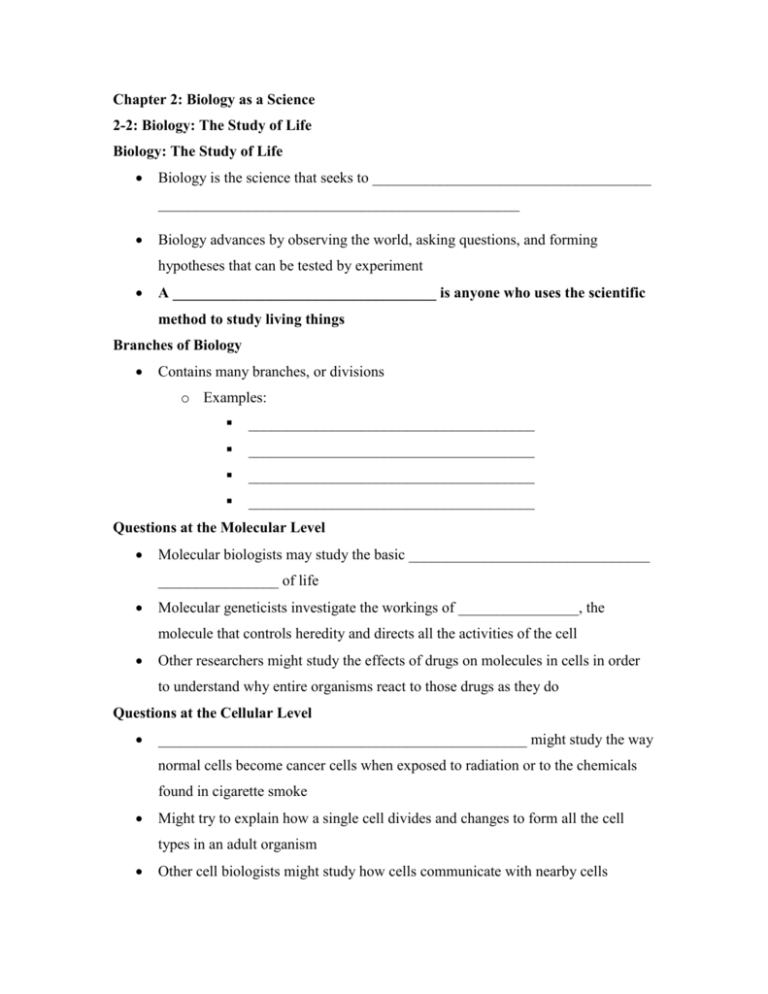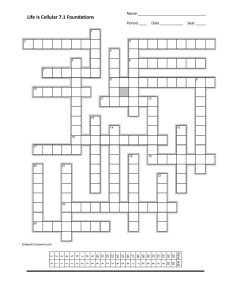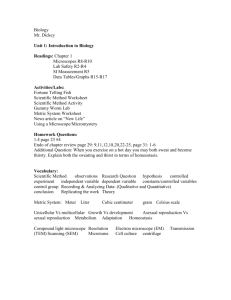2.2 Notes
advertisement

Chapter 2: Biology as a Science 2-2: Biology: The Study of Life Biology: The Study of Life Biology is the science that seeks to _____________________________________ ________________________________________________ Biology advances by observing the world, asking questions, and forming hypotheses that can be tested by experiment A ___________________________________ is anyone who uses the scientific method to study living things Branches of Biology Contains many branches, or divisions o Examples: ______________________________________ ______________________________________ ______________________________________ ______________________________________ Questions at the Molecular Level Molecular biologists may study the basic ________________________________ ________________ of life Molecular geneticists investigate the workings of ________________, the molecule that controls heredity and directs all the activities of the cell Other researchers might study the effects of drugs on molecules in cells in order to understand why entire organisms react to those drugs as they do Questions at the Cellular Level _________________________________________________ might study the way normal cells become cancer cells when exposed to radiation or to the chemicals found in cigarette smoke Might try to explain how a single cell divides and changes to form all the cell types in an adult organism Other cell biologists might study how cells communicate with nearby cells Questions at the Multicellular Level Goes beyond ________________________________________________ Study changes in ___________________________________________________ Questions at the Population Level Interested in _______________________________________________________ that make up populations and how these populations interact with their environment Questions at the Global Level Takes a more worldwide view of biology and are concerned with organisms and their environment on a _____________________________________ Biologists are both studying and trying to preserve the wonderful things that are alive on planet Earth – not just for their own use, but for the use of those who will live on this planet after us Tools of a Biologist Use a wide variety of tools o ___________________________________________ o ________________________________ o ________________________________ To study small organisms, researchers have developed several kinds of ____________________________________ Microscopes are instruments that produce larger-than-life images, pictures, or even videotapes The Compound Light Microscope Most commonly used microscope Make it possible to observe many kinds of cells and small organisms while _________________________________________________ To view – o Object is placed on a microscope slide and covered with a cover slip o It is then placed on the stage of the microscope so that light passes through it into the lenses of the microscope Lens at the bottom = ______________________________________ Lens at the top = ___________________________________ Because both lenses are used to form an image, it is properly known as a ____________________________________________________________ Limits of Resolution There are limits to what can be seen with the compound light microscope As the magnification is increased, more and more detail can be seen – up to a certain point Beyond this point, called the __________________________________________, objects get blurry and detail is lost For standard light microscopes, the limit of resolution is about ______________________________________ Using a Compound Light Microscope Many specimens are ______________________________ before they are observed under a microscope Stains are used to color ______________________________________________ to make them clearly visible Because many stains kill living cells, special types of light microscopes that do not require staining are used to observe __________________________________ ___________________________ Each uses a different property of light rays to improve the clarity of the image o Phase contrast microscope o Dark field microscope o Nomarski microscope Electron Microscopes In the 1920s physicists in Germany realized that electromagnets could bend streams of __________________________________ They used these electromagnets to build electron microscopes The limit of resolution of electron microscopes is about _____________________ finer than the light microscope ________________________________________________________________ – shine a beam of electrons at a sample and then magnify the image onto a fluorescent screen and the bottom of the microscope ________________________________________________________________ – beam of electrons scans back and forth across the surface of a specimen; electrons that bounce off the specimen are picked up by detectors that provide the information to form an image on a television screen Limitations of Electron Microscopes Extremely useful but do have serious drawbacks Specimens must be placed inside a ___________________________ and cut into very thin slices Specimens must be completely ___________________________ before they are placed in the vacuum Living cells ____________________________________________________ in the electron microscope – they are killed by the sample-preparation processes Probe Microscopes Developed in the ___________________ Do not use lenses to produce images Trace the surfaces of a sample with a fine tip known as a probe Have revolutionized the study of ______________________________ and have even made it possible to observe ______________________________________ Specimens do NOT need to be placed in a vacuum Laboratory Techniques of a Biologist In addition to staining, the following techniques are also used in the laboratory o _______________________________________ o _______________________________________ o _______________________________________ Centrifugation Involves placing cells in a _____________________________ to break them apart o Cell fractionation The broken bits of cells are then placed in a liquid in a tube The tube is inserted into a centrifuge, which is a device that can spin the tube up to ___________________________________________ While spinning, the cell parts begin to separate – with the heaviest parts setting near the bottom of the tube A scientist can then remove the specific part of the cell to be studied by selecting the appropriate layer Micromanipulation Another technique to remove parts of a cell is called _______________________ ______________________________, which is a form of micromanipulation o Special tools that are so small they can be used only by looking through a microscope are used to dissect, remove, insert, or otherwise manipulate specific parts of a cell Cell Cultures Sometimes scientists want to study a particular kind of cell but to do so they need __________________________________________________________________ To obtain a cell culture, a single cell is placed in a dish that contains the nutrients the cell needs The cell is allowed to _________________________________ so that in time an entire population is grown from that single original cell





